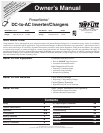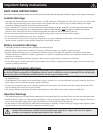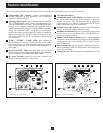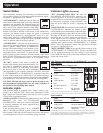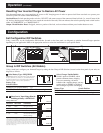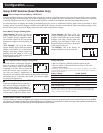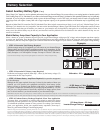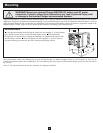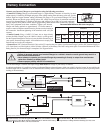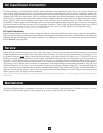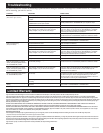
7
Battery Selection
Select Auxiliary Battery Type (if any)
Select“DeepCycle”batteriestoreceiveoptimumperformancefromyourInverter/Charger.Donotuseordinarycarorstartingbatteriesorbatteriesrated in
ColdCrankingAmps(CCA).IfthebatteriesyouconnecttotheInverter/ChargerarenottrueDeepCyclebatteries,theiroperationallifetimesmaybe significantly
shortened.IfyouareusingthesamebatterybanktopowertheInverter/ChargeraswellasDCloads,yourbatterybankwillneedtobeappropriately
sized(largerloadswillrequireabatterybankwithalargeramp-hourcapacity)ortheoperationallifetimesofthebatteriesmaybesignificantlyshort-
ened.
Batteries of either Wet-Cell (vented) or Gel-Cell /AbsorbedGlassMat(sealed)constructionareideal.6-volt“golfcart”,MarineDeep-Cycleor
8DDeep-Cyclebatteriesarealsoacceptable.You must settheInverter/Charger’sBatteryTypeDIPSwitch(seeConfigurationsectionformore
information) to match the type of batteries you connectoryourbatteriesmaybedegradedordamagedoveranextendedperiodoftime.In
manycases,thevehiclebatterymaybetheonlyoneinstalled.Auxiliarybatteriesmustbeidenticaltothevehiclebatteriesiftheyarecon-
nected to each other.
Match Battery Amp-Hour Capacity to Your Application
SelectabatteryorsystemofbatteriesthatwillprovideyourInverter/ChargerwithproperDCvoltageandanadequateamp-hourcapacity
topoweryourapplication.EventhoughTrippLiteInverter/Chargersarehighly-efficientatDC-to-ACinversion,theirratedoutputcapacities
arelimitedbythetotalamp-hourcapacityofconnectedbatteriesandthesupportofyourvehicle’salternatoriftheengineiskeptrunning.
Example
Tools
300W + 220W + 20W = 540W
¼" Drill
Orbital Sander
Cordless Tool Charger
Appliances
300W + 140W + 100W = 540W
Blender Color TV Laptop Computer
• STEP1:DetermineTotalWattageRequired
Add the wattage ratings of all equipment you will connect to your Inverter/Charger.
Wattage ratings are usually listed in equipment manuals or on nameplates. If your
equipment is rated in amps, multiply that number times AC utility voltage to determine
watts.(Example:a¼in.drillrequires2½amps.2½amps×120volts=300watts.)
Note: Your Inverter/Charger will operate at higher efficiencies at about 75% - 80% of nameplate rating.
• STEP2:DetermineDCBatteryAmpsRequired
Dividethetotalwattagerequired(fromstep1,above)bythebatteryvoltage(12)
todeterminetheDCampsrequired.
• STEP 3: Estimate Battery Amp-Hours Required (for operation unsupported
by the alternator)
MultiplytheDCampsrequired(fromstep2,above)bythenumberofhoursyou
estimate you will operate your equipment exclusively from battery power
before you have to recharge your batteries with utility- or generator-supplied
AC power. Compensate for inefficiency by multiplying this numberby1.2.This
will give you a rough estimate of how many amp-hours of battery power (from
one or several batteries) you should connect to your Inverter/Charger.
NOTE! Battery amp-hour ratings are usually given for a 20-hour discharge rate. Actual amp-hour capacities are less when batteries are discharged at faster rates. For example, batteries discharged
in 55 minutes provide only 50% of their listed amp-hour ratings, while batteries discharged in 9 minutes provide as little as 30% of their amp-hour ratings.
• STEP 4: Estimate Battery Recharge Required, Given Your Application
You must allow your batteries to recharge long enough to replace the charge
lost during inverter operation or else you will eventually run down your batteries.
To estimate the minimum amount of time you need to recharge your batteries
given your application, divide yourrequiredbatteryamp-hours (fromstep3,
above) byyourInverter/Charger’sratedchargingamps.
NOTE! For Tripp Lite Inverter/Chargers providing 1250 watts or less of continuous AC power, a full-size battery will normally allow sufficient power for many applications before recharging is
necessary. For mobile applications, if a single battery is continuously fed by an alternator at high idle or faster, then recharging from utility or generator power may not be necessary. For Tripp Lite Inverter/
Chargers over 1250 watts used in mobile applications, Tripp Lite recommends you use at least two batteries, if possible fed by a heavy-duty alternator anytime the vehicle is running. Tripp Lite Inverter/
Chargers will provide adequate power for ordinary usage within limited times without the assistance of utility or generator power. However, when operating extremely heavy electrical loads at
their peak in the absence of utility power, you may wish to “assist your batteries” by running an auxiliary generator or vehicle engine, and doing so at faster than normal idling.
540 watts ÷ 12V = 45 DC Amps
45 DC Amps × 5 Hrs. Runtime
× 1.2 Inefficiency Rating = 270 Amp-Hours
270 Amp-Hours ÷ 55 Amps
Inverter/Charger Rating = 5 Hours Recharge



